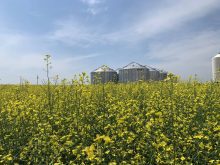The biofuel market in North America is rapidly expanding, thanks in part to government regulations promoting clean fuels to drive down greenhouse gas emissions.
This, in turn, is driving up demand for biofuel feedstocks like canola oil, which is why Chris Vervaet says grain companies are spending some $2 billion over the next few years to boost canola crush capacity in Western Canada. Vervaet, who is the executive director of the Canadian Oilseed Processors Association, says he believes that’s something to get excited about.
“This is really going to be a good news story for canola farmers and the entire canola value chain, frankly,” says Vervaet, who maintains more competition for canola seed and increased crush capacity will not only support higher values for canola but will also provide other important benefits for Prairie farmers.
Read Also

Claas brings 1000 Series SP forage harvesters to Canada
In mid-August, Claas unveiled its new line of Jaguar forage harvesters at an event in Visalia, California, deep in the heart of that state’s dairy region.
According to Vervaet, the demand for biodiesel and renewable biodiesel in North America is expected to climb to more than 17 billion litres by 2030. Both biodiesel and renewable diesel can be derived from vegetable oils but they are processed differently.
Vervaet says while Canada currently doesn’t produce any renewable biodiesel, production facilities will be coming online, which could see Canada produce up to four billion litres of it by 2030.
He notes the main driver for this burgeoning market is the emergence of new, low carbon or clean fuel regulations, both in Canada and the United States.
“It’s about government policy and regulation. That’s a big part of it. And really this pertains to any biofuel market,” says Vervaet. “In Canada, we’ve seen the final publication of the Clean Fuel Regulations in July, which is a pretty big step after five or six years of consultations on that regulation.
“In the United States, we also see a suite of different regulations and policies that support biofuel demand as well. You add those two together and we really do see in the coming years increased demand for feedstock like canola to lower the carbon footprint of transportation fuels in Canada and the United States.”
Vervaet expects biofuel to be a big demand driver not only for canola but for soybeans as well. “On the soybean side of the ledger, there’s also a lot of expansion of soybean crush happening in the United States, and again it’s largely because of the prospects of increased demand for biofuels in North America.”

New crush plants
In Canada, the burst in biofuel demand has helped spur grain handling giants like Richardson International, Cargill and Viterra to unveil plans to construct new canola crush plants or expand existing crush facilities in Western Canada.
Richardson International announced in March 2021 it was doubling its annual crushing capacity to more than 2.2. million tonnes of canola at its plant in Yorkton, Sask. The project is expected to be completed in early 2024.
Cargill announced in April 2021 it would build a new canola crush facility in Regina, Sask., to support growing global demand for canola. Construction of the $350-million plant, which will have an annual capacity of one million tonnes, started this past July and is slated to be completed by early 2024. In addition, Cargill stated it was updating and modernizing two other canola crush locations in Clavet, Sask., and Camrose, Alta., to increase volume and capabilities at both plants.
Also in April 2021, Viterra announced plans to build a “world-class” canola crushing facility in Regina. The annual crush capacity for the plant, which is targeted to be operational in late 2024, would be 2.5 million tonnes, making it what Viterra calls “the world’s largest integrated canola crush facility.”
This past January, Federated Co-operatives Limited (FCL) and AGT Food and Ingredients announced they had signed a memorandum of understanding to build a $360-million canola crush facility in Regina. The plant, which will have an annual capacity of 1.1 million tonnes of canola seed, is part of a larger plan that includes an FCL renewable diesel facility.
Earlier this year, Ceres Global Ag announced a proposal to build a new canola crush plant and biodiesel refinery along the Canada-U.S. border at Northgate, Sask., but in June the company said it was suspending the initiative.
Vervaet maintains if all goes according to plan, canola crush capacity in Canada could reach 16 million tonnes annually once everything’s online in a few years’ time. More crush plants mean new players coming into the market, he says, which should provide canola producers with more delivery options and greater marketing flexibility.
“A farmer doesn’t necessarily have to pick between just one or two delivery points. They could have three or four,” he explains. “If they happen to be close to Regina, for example, they may have as many as four or five, when you look at both the processing footprint and the traditional country elevators as well.”
MarketsFarm analyst Bruce Burnett says he believes when western Canadian producers have more marketing choices, it’s bound to change the dynamics of canola pricing, since farmers will have more opportunities and leverage to land a better basis and price for their canola crop.
“As you get more and more (crush) capacity, particularly if you live in areas where you’ve suffered from a poor basis because of, let’s say, slackness in the export market, the additional capacity will certainly make a difference in terms of your ability to market your canola,” says Burnett.
Vervaet says he believes having a larger Canadian market for canola producers is also desirable from a market diversification and risk reduction perspective. He says having more domestic buyers should reduce dependence on export markets like China, where market access has been unpredictable over the last decade or so.
“Perhaps you don’t have the same reliance anymore on those unpredictable export markets,” says Vervaet. “We’ll have this market in our own backyard that is more secure and more predictable, which is helpful for farmers and the entire value chain.”
More canola needed
Vervaet says with the dramatic rise in crush capacity, the onus will be on farmers to ensure there is adequate supply to keep up with rising demand for canola seed — something that will require a significant boost to canola production in Canada and a concerted effort from everyone in the canola industry.
“We’re going to need to produce more. This is the top priority for the canola value chain, and it’s probably never been more pronounced than it is now because we see this new biofuel demand coming online,” he says. “It’s more on the yield side of the equation. There’s probably room for some more acres, but it’s really about increasing the amount of canola that we can produce per acre.”

Canola production did go up on Canadian farms this year but, of course, this is after the drought year of 2021, which saw meagre canola crops for many producers. According to a July 2022 crop estimates report from Statistics Canada, Canadian canola production was expected to rise 41.7 per cent to 19.5 million tonnes this year over last. This is due to better growing conditions boosting the national yield average to 40.5 bushels per acre (a whopping 47.8 per cent improvement from 2021).
Even so, that’s still quite a bit below the 52-bushels-per-acre target set by the Canola Council of Canada as a national yield goal for canola producers for 2025. Vervaet, however, remains cautiously optimistic.
“We don’t have much time to meet that goal (but) we’re confident as a value chain we’ll continue to be able to increase our yields going forward,” he says. “We have made a lot of progress over the decades in terms of the industry’s ability to meet the growing demands for canola, and to do more on the same amount of acres with a multi-faceted approach to increasing productivity.”
Vervaet is hopeful growth in the biofuel market will spur investment and innovation in the Canadian canola industry to new heights and help boost production by providing farmers with more tools and technology that support improvements in canola yields.
Coming up with improved, higher-yielding varieties is one way to do that, but Vervaet says he believes much more can be done to foster innovation in agronomic practices too. He notes the Canola Council of Canada (CCC) has lots of advice for farmers to improve productivity, such as recommendations for improving fertilizer efficiency and suggestions for different harvest techniques that ensure there is minimal canola loss.
Agronomy priorities
To help canola growers with the national yield target it has set for 2025, the CCC has a list of five agronomic priorities it maintains should not only boost productivity but also make farms more profitable and sustainable. Clint Jurke, CCC agronomy director, says the priorities are science-based actions identified by the CCC’s team of agronomy specialists.
“We believe farmers have all of the technology and tools available currently that we could be getting this 52-bushel average yield, provided there aren’t any more record-breaking droughts,” says Jurke. “We believe that we can do this. It’s just a matter of understanding which of the tools are going to do most of the heavy lifting.”
The CCC’s five agronomy priorities include the following:
- Use 4R nutrient management practices (right rate, right source, right place, right time).
- Choose the best seed traits for each field.
- Achieve a uniform five to eight plants per square foot.
- Identify and manage the top yield robbers.
- Harvest all seeds and deliver them at No.1 grade.
Jurke says by packaging key agronomic information into these five categories, “now we have something that’s hopefully a little simpler, a little more succinct, and that can be communicated to farmers that if (they) pay more attention to these five things, (they) will have more success going forward.”
Use 4R nutrient management practices
Applying the right fertilizer products at the right rate, right time and right place improves yields and reduces losses for farmers. However, a CCC survey of Prairie canola producers in the winter of 2020-21 showed only 24 per cent of respondents had a 4R nutrient management plan. Jurke says that number needs to be much higher.
[RELATED] How much do you know about 4R nutrient management?
“If growers can do a better job with their fertility decisions and their practices, then we know they will get better yields,” says Jurke. “Our target is to get 90 per cent of all acres on a 4R plan.”
Jurke says with fertilizer prices as high as they are, “farmers really need to make sure they’re getting dollar value out of every granule of fertilizer they put into the ground. This is where following the 4R nutrient program is going to help make sure that fertilizer is maximized, that none of it goes to waste.”
Choose the best seed traits for each field
Jurke says it’s not unusual for Prairie producers to rely on one or two canola varieties that promise high yields but may not get the desired results. He maintains that’s often because they’re not selecting the right traits for their fields.
The CCC agronomy specialists recommend farmers base their seed purchasing decisions on the best fit for each field. This can include disease resistance, weed control, days to maturity, pod-shatter resistance and other considerations. Also, producers can help weatherproof their canola by choosing cultivars that are consistently high yielding in various conditions and pest scenarios. The CCC has a tool for agronomists and farmers to compare cultivars at canolaperformancetrials.ca.
Jurke acknowledges with dozens of varieties commercially available, it can be difficult to choose the right one. He says canola producers who systematically select traits that address limitations within each field first, before selecting for yield, will have the best results.
Aim for a uniform five to eight plants per square foot
A consistent and uniform plant stand across the entire field is required for canola crops to reach their full yield potential. It also leads to consistent growth stage timing, which in turn helps with pesticide application timing.
Jurke says meta-analyses based on newer canola studies in Western Canada showed a uniform plant stand of five to eight plants per square foot will maintain the yield potential of canola.
He adds farmers need to factor in the risk potential of their fields when setting their plant stand targets. The CCC has some online calculators that can help canola producers set the right seeding rates to achieve their target stands.
Tackle the top yield robbers
Weeds, pests, soil types, mechanical problems, you name it — there are all kinds of things that can affect canola yields. The CCC agronomy team maintains the key to curbing yield loss is identifying the largest limiting factors and then focusing your time as well as your inputs on addressing those problems. It’s a big reason why scouting fields regularly is so important.
“The intent behind this is to encourage farmers to spend more time in the field looking at their crops and trying to understand where the limitations are and what’s causing issues for them,” says Jurke.
The CCC has scouting and management tips for major canola pests in the Diseases, Weeds and Insects chapters at canolaencyclopedia.ca.
Harvest all seed
Jurke explains the idea behind this principle is to deliver every seed at No.1 grade and leave none behind. For farmers to do this, he says, they need to: 1) give all seeds time to mature, 2) harvest with minimal losses, and 3) store canola without spoilage. Canola producers can find tips for all of these objectives in the Harvest and Storage chapters at canolaencyclopedia.ca.

“We do know that most years most farmers are losing a couple of bushels at the back end of the combine,” says Jurke. “If a farmer can spend more time with setting up the combine for each field and measuring the actual loss coming out of the back end of the combine, then I think they can minimize that loss quite significantly.”
Jurke says the CCC grower survey showed straight cutting rather than swathing canola was associated with higher yields for survey respondents who farm in the southwest Prairies. The survey results also indicated those respondents who did swath generally saw yield improvements when they swathed at 60 per cent seed colour change or later.
“A message that we’ve been talking about in the industry for 20 years is swath at 60 per cent seed colour change or later. Especially now that we have shatter-resistant varieties, swathing at 80, 90 per cent seed colour change is totally doable nowadays. You won’t lose very much seed with those modern cultivars or varieties,” says Jurke.
“If the grower waits for that 80 to 90 per cent, the likelihood is going to be (they’ll see) a five per cent additional yield gain. The later you can wait, the better the yields.”
















